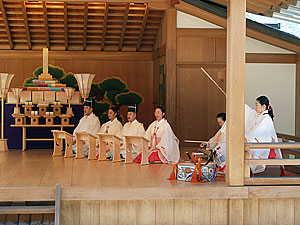An Encounter With Oomoto Through Aikido
Learning about the spiritual aspects of the martial arts
By Nevada Taylor
Nevada Taylor, a Canadian living in Osaka and practicing Aikido with one of Oomoto’s teachers, gave the following speech at the Kii Branch in Wakayama Prefecture on April 13, 2008.
I would like to thank Oomoto and the Kii Branch for letting me speak today. I would also like to thank Mr. Yano for translating. I can speak some Japanese, but I’m not fluent.
I have been to many daily services held at Oomoto, but this is my first time to attend a Tsukinamisai and it is a nice experience to be a part of Tsukinamisai as part of my Oomoto experience. I’m very happy to be here.
I know that your guest speakers usually tell you how they first came to, or came to know about Oomoto, but first let me tell you how I came to Japan. There were two reasons: The first had to do with my schooling at the time, and the second was the martial arts.
I grew up in a really small town in southwestern Ontario, Canada, called Chatham. It is approximately four hours by car from Toronto and one hour from Detroit, Michigan, which is across the border in the United States. Chatham is mostly a farming community.
Ontario is truly a beautiful province. As you may know, it has many special nature sites. Not far from my hometown there are many beautiful places, including Point Pelee National Park and Rondeau Provincial Park, both situated on Lake Erie.
Not far from Point Pelee is Jack Miners Bird Sanctuary. Algonquin Provincial Park, located in central Ontario, is also a very popular destination for many travelers. Algonquin was the first provincial park in Ontario. It has 7,630 square kilometers, which makes it just slightly smaller than two times the size of Wakayama Prefecture. And of course, I am sure you all know about the majestic Niagara Falls, another one of Ontario’s beautiful sites. Maybe you have visited it, or at least seen photos.
On a personal note, every summer my family would pack up and head to a small two room cottage we had on Lake Erie. Some of the best times of my life were when I was at this cottage.
I can recall many times sleeping outside on the beach under the stars on a warm summer night beside a slow-burning bond fire. I always appreciate nature, and having an abundance of nature surrounding me while growing up was wonderful.
Bullies were motivation for the martial arts
I don’t know exactly how I first came to know of my interest in the martial arts, but it could have been because I was picked on so much as a kid. I used to wear glasses and this always seemed to single me out as an easy target. It was not unusual for me to be bullied at school and to come home with broken glasses and ripped clothes. I didn’t have many hobbies at that time so my father agreed when I asked to join some kind of martial arts club.
Because Chatham was such a small town the only martial arts program available was Tae Kwon Do, which as you probably know is mainly a sport martial art that originated in Korea. I enrolled in Tae Kwon Do, and soon after found a second dojo, which I found out much later was Shorinji Kenpo, a derivative of Chinese Kenpo also found here in Japan.
I didn’t stay interested in Tae Kwon Do very long because at the Kenpo dojo we practiced joint techniques, and for some reason joint techniques inspired me more than just punching and kicking. I started my training around the age of 7 in Shorinji Kenpo and then later started Aikido after entering junior high school.
I recall one event that got me interested in Aikido. It happened when I attended an annual locally held tournament. There was a girl practicing Aikido who was a friend of one member of the group we were with. She was throwing her partner around, and probably because I was cocky I challenged her to throw me -- and she did. I was not only surprised by the throw, but by the pin that followed. And from that day on because I really liked to study joint techniques I knew that I would probably like Aikido, too.
But there was no Aikido in my hometown. And unlike in Japan, it was quite difficult to find a place to train in Aikido. A group of us began to carpool for Aikido training in Windsor, the closest city, about an hour away. Windsor is in Canada, across the American/Canadian boarder from Detroit.
At the dojo in Windsor, I studied Yoshinkan Aikido, which is more of a military style of Aikido developed by Gozo Shioda Shihan. It is the type of Aikido that is usually taught to the Tokyo Police. It was brought to America by Sensei Takashi Kushida, who still manages a dojo in the U.S. near Detroit in the town of Ann Arbor, Michigan. I studied with one of his pupils, Sensei Kevin Blok, who I believe at one time commuted to Ann Arbor from Windsor. After beginning college I then could study Aikido right at my university club in London, Ontario.
Kobe earthquake brought him to Japan
Even though my passion was in the martial arts, it was not the reason for my first visit to Japan, which was in 1994. In Canada I graduated college in Architectural Technology, but during my college days there was the Hanshin Daishinsai; the earthquake that devastated Kobe.
I decided after speaking with one of my college professors, that it would be good to offer my help as a volunteer in Kobe’s reconstruction after graduating. I didn’t arrive in Kobe until long after the earthquake and unfortunately did not participate in the cleanup. When I arrived in Kobe I was mostly doing computer aided design, otherwise known as CAD work. It was somewhat difficult because I wasn’t able to understand the language then. Most of the CAD work I did was then edited with Japanese commentary after.
Sorry for being longwinded, but it was this unfortunate twist of destiny that allowed me to come to Japan and led to my later training here at Oomoto. My first encounter with Oomoto came not long after, in the spring of 1997.
My memory is somewhat foggy, but the earliest dates on some of my pictures are April 1997. Ironically, one of the pictures I took was of me in front of Hosukan Dojo, which is the dojo I presently practice at in Kameoka now. I had the chance to visit Oomoto both in Kameoka and Ayabe over a couple of days on a group excursion with members from the Tenshin Dojo in Osaka, one of the dojos I have previously practiced with.
"Breathtaking" would be an accurate description of my first impression of Oomoto. Nature surrounds Oomoto and there is a deep feeling of relaxation whenever one goes to the Oomoto grounds. It is this peacefulness and openness that helped me with many problems I have faced in my life. Oomoto has helped me with loneliness in Japan, getting over the death of a loved one in my family, and returned me to Aikido when I was at a point of giving up and ready to throw in the towel.
Living and working in Japan
Since I graduated from college I have been back and forth to Japan numerous times. This time I returned to Kansai in 2005 and have been here for about three years. When I first came to Japan this time, I was practicing Aikido up to five times a week, but now because of the pressures of work, I usually try to practice two or three times in a week. This past year I usually have driven from Toyonaka up to Kameoka on Thursday nights and sometimes driven to Ayabe on Wednesday nights, depending on the road conditions.
Most of the time, I make the drive on a motorbike, which I bought to get to practice. I also like to train at a local Budokan near my home on Tuesdays and/or Saturdays during open practice. With the rest of my time I’m usually working. I manage a small language school, which gives me enough income to keep practicing Aikido and to remain in Japan.
As you are most certainly aware of, Aikido is deeply rooted in Oomoto. Remembering where the principles and beliefs of Aikido came from is extremely important to me. Oomoto’s great love of nature and the arts were passed down to Aikido through its founder, Morihei Ueshiba(1883-1969) , an Oomoto follower. While teaching Aikido, it is these characteristic traits I hope to one day pass on to my students to allow them to grow in understanding.
A different perspective on martial arts
In North America, martial arts are usually perceived by the general population as nothing more than fighting methodologies, which is to say that most do not view martial arts as any kind of art at all, unfortunately. The English dictionary defines the word “martial” as: "warlike; suited to or loving war. Fighting strategies used in military hand to hand combat." But the meaning “martial arts” is somewhat of a misnomer because in martial arts there should be nothing “warlike” about it.
There is one line that I heard while practicing Aikido, which I like to remember. It is that “Budo is beautiful.” I cannot agree with this more, and I like to remember this expression while practicing my own waza. I have come to respect all forms of Budo, and I believe all art styles are interrelated. One time while watching a demonstration I was surprised to see an Aikido instructor teaching many different techniques with a Japanese sensuu because of the same footing and motion of hand.
In the past, I used to practice Iaido, Yagu Shin Kage Ryu, and Ono-ha Itto Ryu, but had to give them up because of moving to and from several different locations. Since Aikido techniques are derived from the katana, many movements taught in Iaido, and other sword arts, are to a degree consistent to the movements found in Aikido.
Although I am interested mainly in Budo, there are many other Japanese arts I wish I could or have time to practice. I have always wanted to study the soroban, taiko, or even get my next level in Japanese language. I believe that language is also another form of art.
Interest in the other Japanese arts
The creative arts are also very inspiring. While taking some classes in Shodo, I found myself very impressed and absorbed watching my teacher elegantly swipe her calligraphy brush across the rice paper. It was much like the many ways that my previous budo sensei taught me.
The Japanese katana is also a wonder to behold. While in Japan, I try to make the best of my time here and make it a point to attend as many cultural events as I can. One such event took me with a group of friends to Tottori to watch how a Japanese katana is forged.
Within the past couple of years I was able to visit and see the pottery kiln and the spinning looms in Ayabe. I was fortunate enough to attend an Oomoto art exhibition held in Kyoto at the Kyoto Museum.
Viewing the great works of the past Spiritual Leaders gave me a further perception into how important art is to Oomoto. This is also the time I was introduced to the concept of art being the mother of religion, as Co-Founder Onisaburo Deguchi put it.
As for Aikido, studying here at Oomoto has been one of the greatest experiences of my life. Not only did I learn effective, practical techniques, but also a better sense of how to help others. Soon after I arrived the first day in Oomoto, I was surprised to see the members greeting me even though I was a complete stranger. Oomoto people are so kind and welcoming to everyone. I hope to always bring this kindness and openness to my own practice.
Oomoto’s openness to other religious groups and people of all nations is another great quality that I have always believed in and wish to emulate. I like to read extensively now compared to when I was a child and a quote which I rather like, but am unsure of origin is, “Remember that everyone you meet is dealing with some kind of problem.”
Understanding and compassion for one another is essential to the practice of many martial arts, including Aikido. I believe that a lot of dojos lose their way if they do not accept students openly. Sadly, many dojos are too absorbed in business and financial growth rather than the growth of their students. I see this more in the West, but it is also the case in Japan. I believe it is far better to use the dojo to create a feeling of brotherhood, which in turn creates good relationships and encourages social interaction.
This is what I have witnessed in the Hosuukan Dojo in Kameoka. My fellow Aikidoka are a great bunch of people. I will miss the times of practicing I had with them.
I would like to take the time before ending this speech to say what an excellent Aikido teacher Shichiryodani Shihan is. I am most fortunate to be his student. He will never know how much he has taught and inspired me. I deeply respect him and thank him for his teachings. Over this past year while studying at Oomoto, Shichiryodani Shihan has been teaching me another world of Aikido and a variety of new techniques to take back to Canada.
It took me a while in the beginning to grab the differences from what I previously came to Hosuukan Dojo with, but with Shichiryodani’s patience I was able to understand techniques one point at a time easily. I really regret not having met him sooner in my life as I could have learnt much more over the time that I have been in Japan this time.
In closing, I would like to say once again what a great experience I have had here during my stay with Oomoto. I would also like to give a great deal of thanks to the people who have made my training here possible. I want to thank you, the people of Oomoto, and Sensei Shichiryodani for not only teaching me techniques in Aikido, but also opening my mental conc
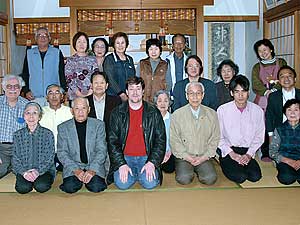
Nevada Taylor with members of the Kumano sub-branch.
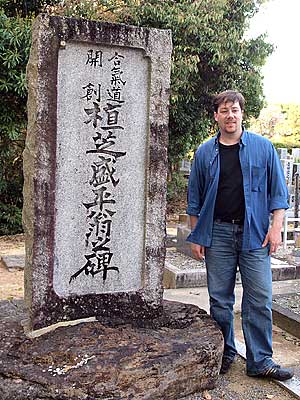
At the grave of Aikido founder Morihei Ueshiba in Tanabe.
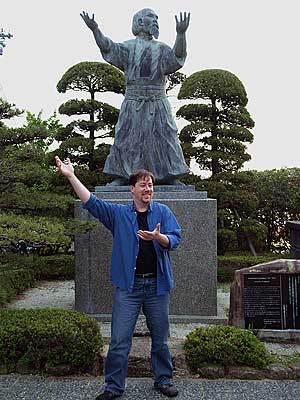
The statue of Morihei Ueshiba in Tanabe.
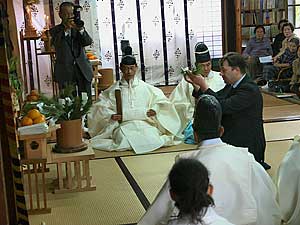
Pine bough offering at the Kii Branch monthly service.
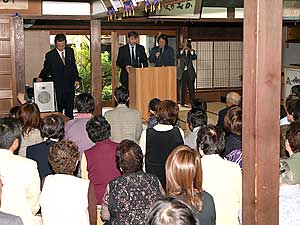
Nevada Taylor addresses the Kii Branch.
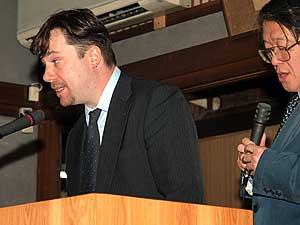
Taylor explains how he came to Japan and to Oomoto.
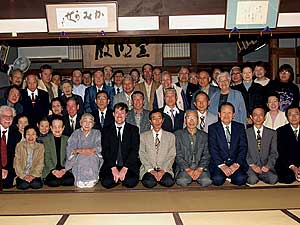
With the Kii Branch members.
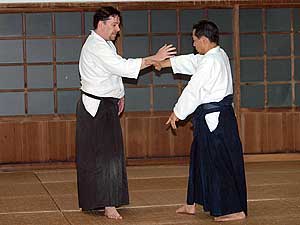
With Shihan Shichiryodani, Aikido teacher and an Oomoto priest.
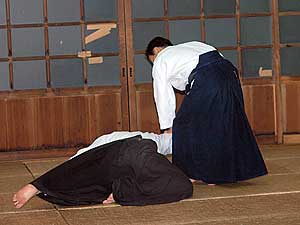
Taylor practices each Thursday in Kameoka.
New Contents Thu, May 20, 2010
- Oomoto participates in Sant’Egidio conference : Dialogue among religions and cultures : On divided island nation of Cyprus By Bill Roberts
- Photo Album : Portraits of three branches: Shoko, Tanegashima and Aomori By Bill Roberts
- Oomoto FAQ
- A Letter from Oomoto : Of mountains and myths By Bill Roberts
- Polyglot poem festival The Utamasturi is going international — what’s next? By Bill Roberts
- Ethics education program captures the spirit of Bankyo Dokon By Bill Roberts
- A Letter from Oomoto : A year’s worth of adventure in a summer of branch visits By Bill Roberts
- In Kumamoto, it’s all about water – and fire By Bill Roberts
- A speech by Nevada Taylor at the Kii Branch in Wakayama Prefecture on April 13, 2008.:An Encounter With Oomoto Through Aikido
- Utamatsuri, Poem Festival, in Tokyo(on April 17, 2008)
- A speech by Neil Ryan Walsh at the Kobe branch on Mar. 9th, 2008.:Planting the Seeds of the Soul
- Meeting with the Fifth Spiritual Leader of Oomoto, Madame Kurenai Deguchi by Neil Ryan Walsh
- A speech by Neil Ryan Walsh at the Nagoya branch on Feb. 17th, 2008.:The Japanese Arts beyond National Boundaries
- To the Oomoto branch in Nagoya: City of Eel and Toyota by Neil Ryan Walsh
- A Speech by Nissim Ben Shitrit, Ambassador of Israel on the occasion of the Oomoto Setsubun Grand Festival in Ayabe February 3rd, 2008 : Japan and Israel : Two Lands Balancing the Needs of Traditional Culture and Modern Life. r
- A permanent memorial to Onisaburo (A Speech at the Autumn Grand Festival , November 6, 2007 : )By James Parks Morton, Founder and Chair, Emeritus of The Interfaith Center of New York
- Israel, Palestine and the Power of Poetry(Oomoto believes small efforts can have lasting ripple effects on people and peace)By Bill Roberts
- “Something Great”(This genetics pioneer, a friend of Oomoto, offers a clue to the mystery of life)By Bill Roberts
- Kamishima Cleanup (Harima branch members regularly visit this sacred island to keep the shrine tidy)By Bill Roberts
- Kyotaro Deguchi was one of six recipients of the 2007 James Parks Morton Interfaith Award
What is Oomoto?
- What is Oomoto?
- Spirtual Centers
- Founders and Spiritual Leaders
- History
- Organization and activities
- Teachings and scriptures
- Art Works of Founders and Leaders
Opinions[Archive]
- Statement of regret for the outbreak of war against Iraq (March 20,2003)
- Jinrui Aizenkai dispatched the "Urgent Appeal for a World (Global) Crisis" on March 14.
Grappling with Bioethics[Archive]
- Oomoto’s support for abolishing the death penalty (12, June 2003)
- The Oomoto Foundation protests any birth of a human clone baby. (5, January 2003)
- OOMOTO'S VIEW REGARDING JAPAN’S PERMITION TO THE RESERCH OF HUMAN EMBRYONIC STEM CELLS (ES cells)(12, June 2000)
Vistor’s Review[Archive]
- A speech by Bill Roberts at the Oomoto branch in Hiroshima after its monthly service on March 18, 2007:Encounters with war and peace
- How Bankyo Dokon changed one life by Linda Macphee
- A speech by Bill Roberts at the Hokuriku (Kanazawa) branch on Dec. 3, 2006:Ritual and myth -an encounter with ‘divine madness’
- A speech by Bill Roberts at the Himeji Cultural Center on Feb. 25, 2007:Mesmerized by the Japanese Arts
- A speech by Bill Roberts at the Kobe branch on Feb. 11th, 2007.:There are just human tears and human joy
- A Speech on the occasion of the Oomoto Setsubun Grand Festival in Ayabe February 3rd, 2007 : Egypt's role in Middle East peace
- Keynote Speech for the 28th World Federation Japanese Religionists Conference for World Peace in Tokyo (at Kokugakuin University, Novermber 29, 2006):Vision for Peace in the Middle East By Dr. Munther S. Dajani, Professor Dean, Faculty of Arts, Al Quds University, Jerusalem
- A speech to the Kyoto branch:Spiritual adventures in researching Oomoto leaders
- A Speech at The Oomoto Foundation on Monday, November 6, 2006 : Jordan's role in Middle East By Samir Nouri, Ambassador of the Hashemite Kingdom of Jordan
- A letter from Oomoto:The Young People of Tottori
- A speech by Bill Roberts on the occasion of the dedication ceremony for the new shrine of Tottori Branch By Bill Roberts Oct. 8, 2006
- A speech by Bill Roberts at the Oomoto branch in Hiroshima after its monthly service on March 18, 2007:Encounters with war and peace
- How Bankyo Dokon changed one life by Linda Macphee
- A speech at Setsubun : A Portrait of Oomoto By Bill Roberts Feb. 3, 2006
- New Publication ! By Bill Roberts Feb. 3, 2006 A Portrait of Oomoto
you can read this book in html => http://www.jinruiaizenkai.jp/English/en-kolumno/en-bill/en-sugao/billbook1en.html
E-mail below to order brobert1@ix.netcom.com
Current Topics
- Prayer Offering and World Religious Forum II
- Living the art of dialogue
- Kyotaro Deguchi was one of six recipients of the 2007 James Parks Morton Interfaith Award
Books
Online Books
- Divine Signposts by Onisaburo DEGUCHI
- The Creation of Meaning by Hidemaru Deguchi
- Bankyo Dokon(Seventy years of Inter-Religious Activity at Oomoto)
- Nao Deguchi — A Biography of the Foundress of Oomoto
- The Great Onisaburo Deguchi published by Aiki News
- Bankyo Dokon Seventy Years of Inter-Religious Activity at Oomoto
- Insearch of Meaning
- Nao Deguchi A Biography of the Foundress of Oomoto
- A Portrait of Oomoto By Bill Roberts
Oomoto international Archive
- The History of Oomoto (Jan.– Mar. 1980 — Apr.– Jun. 1982)
- The Ancestors; Friends or Foes? (Apr.– Jun. 1987)
- Tsukinamisai; The Sabbath of Shinto (Jan.– Jun. 1983)
- The Poem Festival at Oomoto; An Ancient Rite Lives Again (Oct.– Dec. 1981)
- Purification of the Universe ; Oomoto's Setsubun Festival (Apr.– Jun. 1981)
Links
Flowers at Ten'on-kyo & Baisho-en (photographs)
Contact
All rights reserved : the Oomoto Foundation Produced by the Netinformational Commission
Since : Mar. 7.1998 Last Update : Thu, May 20, 2010
E-mail : webmaster@oomoto.or.jp
Top Page Nihongo Esperanto Português Roomazi



